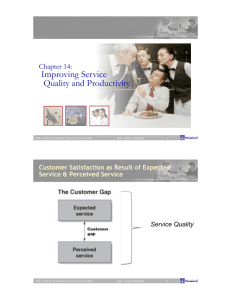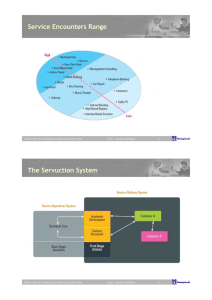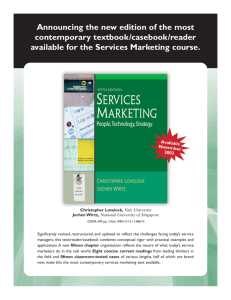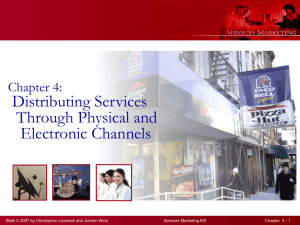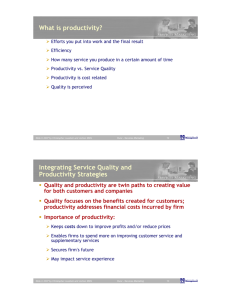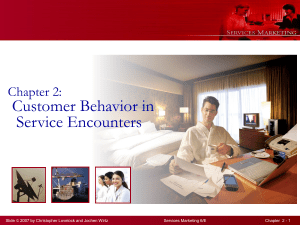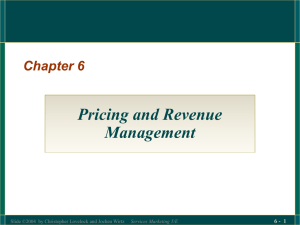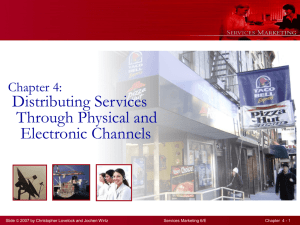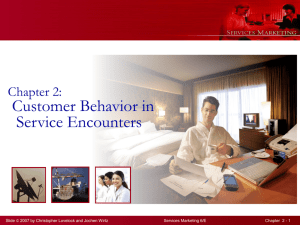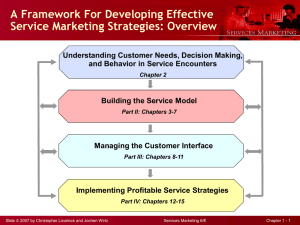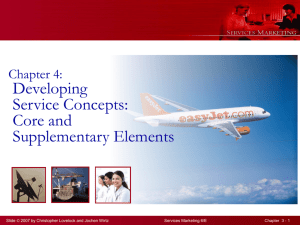Improving Service Quality and Productivity
advertisement
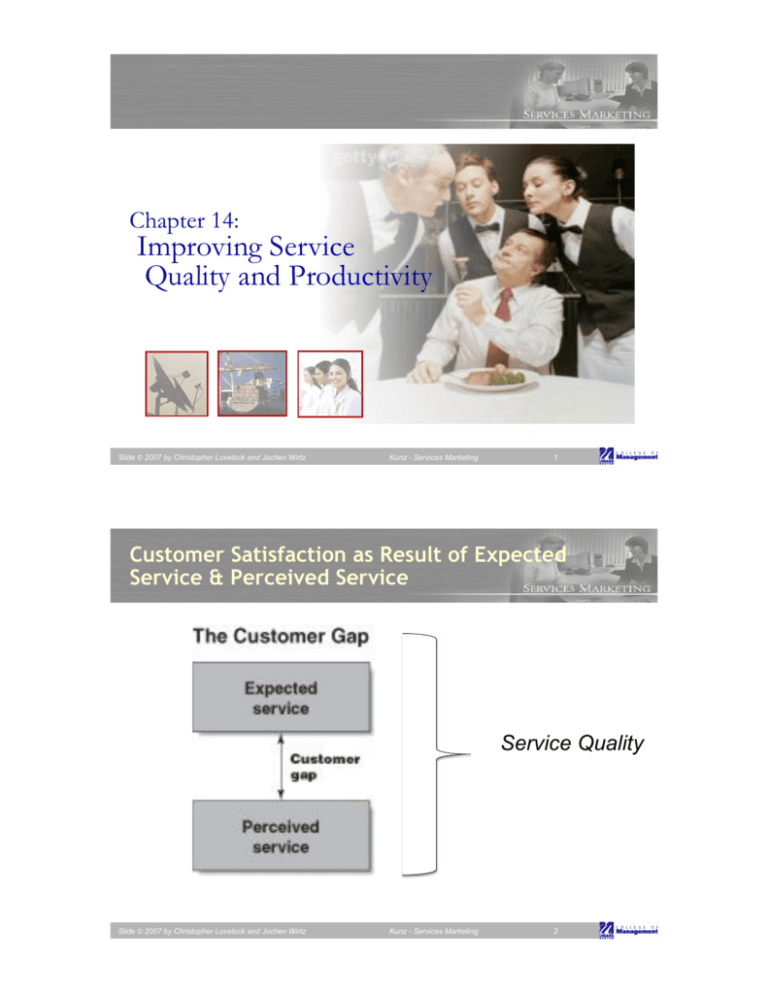
Chapter 14: Improving Service Quality and Productivity Slide © 2007 by Christopher Lovelock and Jochen Wirtz Kunz - Services Marketing 1 Customer Satisfaction as Result of Expected Service & Perceived Service Service Quality Slide © 2007 by Christopher Lovelock and Jochen Wirtz Kunz - Services Marketing 2 Seven Service Quality Gaps (Fig 14.3) CUSTOMER Customer needs and expectations 1. Knowledge Gap MANAGEMENT Management definition of these needs 2. Standards Gap Translation into design/ delivery specs 4. Internal Communications Gap 3. Delivery Gap Execution of design/ delivery specs Advertising and sales promises 4. 6. Interpretation Gap 5. Perceptions Gap Customer perceptions of service execution Customer interpretation of communications 7. Service Gap Customer experience relative to expectations Slide © 2007 by Christopher Lovelock and Jochen Wirtz Kunz - Services Marketing 3 !"#$%"&'()*+,)+%-"#+ • !"#$%&$'()$*+,-.)/0)$!"#.+/#0"*+120,+,2#+%-$,)3#"+10*,$+ • !"#$1&$'()$23"+/"4/5$!"#.+4$,056&$2+,2#+7&82,+9#":&%#+!")%#$$#$+0*;+ 9'#%&<=+9,0*;0";$>$ • !"#$6&$'()$7).89)4:$!"#;$4*$-"#+,20,+!#"<)"30*%#+?##,$+9,0*;0";$>+ • !"#$<&$'()$=+3)4+".$>,??@+8A"B,+5$!"#;+4*$-"#+@20,+A)33-*&%0()*+ !")3&$#$+B"#+7#06&$(%>+ • !"#$C&$'()$D)4A)#B,+$!"#;$@0*8&5&6&C#+0*;+A)33-*&%0,#+,2#+9#":&%#$+ D-06&,=+E#6&:#"#;>+ • !"#$E&$'()$=+3)4#4)3"B,+$!"#;$F#+$'#%&G%+1&,2+,2#+!")3&$#$+0*;+?0*08#+ A-$,)3#"$ +H*;#"$,0*;&*8$+)<+,2#+A)33-*&%0()*+%)*,#*,>+ • !"#$F&$'()$2)498A)$!"#;$+A6)$#+I0'$+JKL+,)+?##,+A-$,)3#"+4M'#%,0()*$+ A)*$&$,#*,6=>$ Group work: GAP Model This project offers you the opportunity to become consultants to a company. Choose a company where you will have relatively unrestricted access to information. Using the GAP Model, diagnose the different gaps that that exist in that company. Come up with recommendations for the company on how to close those gaps. In order to complete the project, you may have to interview their customers, and the staff from various departments like marketing, human resource, and operations. Slide © 2007 by Christopher Lovelock and Jochen Wirtz Kunz - Services Marketing 5 Soft and Hard Measures of Service Quality ! Hard measures—can be counted, timed, or measured through audits " Typically operational processes or outcomes " Standards often set with reference to percentage of occasions on which a particular measure is achieved " Control charts are useful for displaying performance over time against specific quality standards ! Soft measures—not easily observed, must be collected by talking to customers, employees, or others " Provide direction, guidance, and feedback to employees on ways to achieve customer satisfaction " Can be quantified by measuring customer perceptions and beliefs ! For example: SERVQUAL, surveys, and customer advisory panels Slide © 2007 by Christopher Lovelock and Jochen Wirtz Kunz - Services Marketing 6 Control Chart for Departure Delays (Fig 14.4) % Flights Departing Within 15 Minutes of Schedule 100% 90% 80% 70% 60% J F M A M J J A S O N Month Slide © 2007 by Christopher Lovelock and Jochen Wirtz Kunz - Services Marketing 7 Components of Quality: Service-based Tangibles: Appearance of physical elements Reliability: Dependable and accurate performance Responsiveness: Promptness; helpfulness Assurance: Competence, courtesy, credibility, security Empathy: Easy access, good communication, understanding of customer Slide © 2007 by Christopher Lovelock and Jochen Wirtz Kunz - Services Marketing 8 D Group work: Develop a ServQual Scale for your Business Please develop a Questionnaire based on the ServQual Dimensions! Please take the table 14.1 and 14.2 as guideline Slide © 2007 by Christopher Lovelock and Jochen Wirtz Kunz - Services Marketing 9 Kunz - Services Marketing 10 What is productivity? " ??? Slide © 2007 by Christopher Lovelock and Jochen Wirtz Integrating Service Quality and Productivity Strategies ! Quality and productivity are twin paths to creating value for both customers and companies ! Quality focuses on the benefits created for customers; productivity addresses financial costs incurred by firm ! Importance of productivity: " Keeps costs down to improve profits and/or reduce prices " Enables firms to spend more on improving customer service and supplementary services " Secures firm’s future " May impact service experience Slide © 2007 by Christopher Lovelock and Jochen Wirtz Kunz - Services Marketing 11 What can you do to increase productivity in your business? Discuss with your neighbor (don’t have to be your group member) " not to much people hired " Operations hours " Optimization of walking ways " Equipment " Ordering process " Supplier selection " Reservation process " Efficiency Slide © 2007 by Christopher Lovelock and Jochen Wirtz Kunz - Services Marketing 12 Improving Service Productivity: (1) Operations-driven Strategies ! Control costs, reduce waste ! Set productive capacity to match average demand ! Automate labor tasks ! Upgrade equipment and systems ! Train employees ! Broadening array of tasks that a service worker can perform ! Leverage less-skilled employees through expert systems ! Service process redesign Slide © 2007 by Christopher Lovelock and Jochen Wirtz Kunz - Services Marketing 13 Improving Service Productivity: (2) Customer-driven Strategies ! Change timing of customer demand " By shifting demand away from peaks, managers can make better use of firm’s productive assets and provide better service ! Involve customers more in production " Get customers to self-serve " Encourage customers to obtain information and buy from firm’s corporate websites ! Ask customers to use third parties " Delegate delivery of supplementary service elements to intermediary organizations Slide © 2007 by Christopher Lovelock and Jochen Wirtz Kunz - Services Marketing 14 Generic Productivity Improvement Strategies ! Typical strategies to improve service productivity: " Careful control of costs at every step in process " Efforts to reduce wasteful use of materials or labor " Replacing workers by automated machines " Installing expert systems that allow paraprofessionals to take on work previously performed by professionals who earn higher salaries ! Although improving productivity can be approached incrementally, major gains often require redesigning entire processes ? Slide © 2007 by Christopher Lovelock and Jochen Wirtz ? Kunz - Services Marketing ? 15 Long Waiting Times May Indicate Need for Service Process Redesign (Fig 14.8) Slide © 2007 by Christopher Lovelock and Jochen Wirtz Kunz - Services Marketing 16 Questions When Developing Strategies to Improve Service Productivity ! How to transform inputs into outputs efficiently? ! Will improving quality hurt productivity? ! Will improving productivity hurt quality? ! Are employees or technology the key to productivity? ! Can customers contribute to higher productivity? Slide © 2007 by Christopher Lovelock and Jochen Wirtz Kunz - Services Marketing 17 Tools to Analyze and Address Service Quality & Profitability Problems ! Fishbone diagram " Cause-and-effect diagram to identify potential causes of problems ! Pareto Chart " Separating the trivial from the important. Often, a majority of problems is caused by a minority of causes (i.e. the 80/20 rule) ! Blueprinting " Visualization of service delivery, identifying points where failures are most likely to occur Slide © 2007 by Christopher Lovelock and Jochen Wirtz Kunz - Services Marketing 18 When Does Improving Service Reliability Become Uneconomical? (Fig 14.7) Satisfy Target Customers through Service Recovery Service Reliability 100% Optimal Point of Reliability: Cost of Failure = Service Recovery B C A Small Cost, Large Improvement Satisfy Target Customers through Service Delivery as Planned D Investment Large Cost, Small Improvement Slide © 2007 by Christopher Lovelock and Jochen Wirtz Assumption: Customers are equally (or even more) satisfied with the service recovery provided than with a service that is delivered as planned. Kunz - Services Marketing 19 Cause-and-Effect Chart for Flight Departure Delays (Fig 14.5) Facilities, Equipment Arrive late Oversized bags Customers Customers Frontstage Front-Stage Personnel Personnel Procedures Procedures Delayed check-in Aircraft late to Gate agents procedure gate cannot process fast enough Mechanical Acceptance of late Failures passengers Late/unavailable Late pushback airline crew Delayed Departures Late food service Other Causes Weather Air traffic Late cabin cleaners Poor announcement of departures Late baggage Weight and balance sheet late Late fuel Materials, Materials, Supplies Supplies Slide © 2007 by Christopher Lovelock and Jochen Wirtz Backstage Personnel Information Kunz - Services Marketing 20
